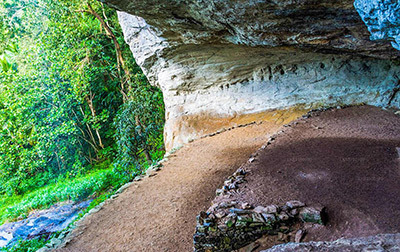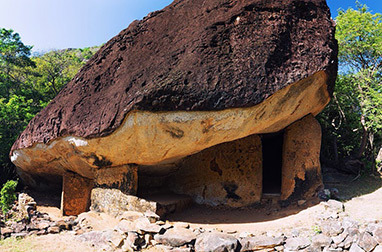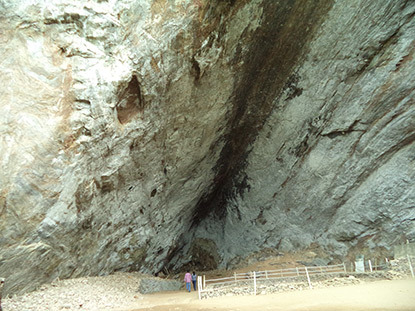Let’s take a look at some of these amazing cave temples of Sri Lanka:
DAMBULLA

Dambulla is most definitely the best example of an ancient sinhalese cave temple concerning the quality and quantity of the murals and statues, found here. Dambulla is the only cave temple declared a World Heritage Site by UNESCO. This cave temple's history goes back to the 1st or 2nd-century BC. The colossal rock shelters, originally serving as monk dwellings, were transformed to image houses in the centuries. The openings of these caves are to the south, which was closed by the walls. The interiors of these caves were decorated with hundreds of Buddha statues, which are said to be built during the Polonnaruwa, Kandy, and Anuradhapura periods. Some traces indicate that a few of these paintings and murals existed already in antiquity.
The beautiful paintings that can be seen today on the ceilings and walls here are from the kandyan period showcasing scenes from Buddha's life.
Witness beauty of the Dambulla Caves in this short video.
PIDURANGALA

The legend says that when King Kassapa transformed the monastic cave complex at the foot of Sigiriya rock to be a part of his grand palace gardens, the monks who lived in Sigiriya got a new abode in the neighboring Pidurangala. It has several long rows of abris that plays a vital role to get closer to Sri Lanka's prehistory. One of the most visited abris (shelter) here is a cave occupied by a reclining Buddha built out of bricks.
Here one can see the parts of the original plaster too. This beautiful statue of Buddha is attributed to King Kassapa, the founder of the sigiriya citadel. Pidurangala also has an ancient reclining Buddha with a colorful kandyan-style coat.
Insider Tip:: The very top of the Pidurangala hill, which is not so easy to climb, acts as one of the best panorama viewpoints in the northern half of Sri Lanka.
BATADOMBALENA

Located not too far away from the capital city of Colombo, Batadombalena is a small rock shelter located inside a rubber plantation. This cave is a kind of "home cave" to father and son Deraniyagala, Sri Lanka's renowned archaeologists' family. They played a vital role in proving that Batadombalena's late Pleistocene inhabitants had a wide range of foods, also constituting monkeys and snakes.
Notably, the finding of marine shells was a hint that there have been early trade contacts between the coast and the hill country. To reach Batadombalena, one has to hike around 1.5 kms through delightful scenery.
FUN FACT: Deraniyagala's finding indicated that the people who lived in Batadombalena used geometric microliths around 31,000 years ago, which was many millennia earlier than in Europe.
BATATOTALENA

A beautiful prehistoric cave temple, Batatotalena today is a Buddhist pilgrimage site. Also known as Diva Guhawa in the Buddhist scriptures, it is believed that the Buddha rested here with 500 followers when ascending the Adam's Peak, where Siri Pada left his footprint.
The caves inside the Diva Guhawa are decorated in the Kandyan style and consist of some exciting features, like a reclining Buddha and Hindu god statues.
FUN FACT: Batatotalena is considered among the 16 Solosmathanas or sites visited by the Buddha during his three journeys to Sri Lanka.
BELI LENA

Beli Lena is situated 600 m above sea level, in the Kelani River Valley. It is a group of comparatively deep caves. One of the caves here has a large excavation area, which was significant for the culture research of prehistoric Balangoda man. Today, Beli Lena has turned into a destination for caving expeditions suitable for the beginners.
The most significant cave entrance is behind a small waterfall which is a very picturesque sight. The region is a paradise for nature lovers for the abundance of butterflies and bird species. A waterfall for abseiling adventures here will surely stun an adventurer.
FUN FACT: At Beli Lena, more than 12,000 years old skeletal remains were found as "Homo sapiens balangodensis" by Paul E. P. Deraniyagala.
DIMBULAGALA

Dimbulagala, also known as Dumarakkapabbata or Udumbaragiri in the ancient chronicles of Sri Lanka, is an isolated mountain range spread over an area of 4 km in length. The British referred to this cave as ‘Gunners Quoin’. Dimbulagala is located 16 km southeast of Polonnaruwa, just opposite to the largest river of Sri Lanka, Mahaweli.
The mountain has historic caves on either side, which were inhabited by the forest monks during the early Anuradhapura period. Near these historical caves lies a systematically planned monastery, now called Namal Pokuna, which was established at the northern slope of the hills.
Insider Tip: Interestingly, at the Pulligoda caves located on the southern foot of the Dimbulagala hills, one can see the second-best frescoes, after the frescoes at Sigiriya. These frescoes date back to the Anuradhapura period.
PAHIYANGALA

Pahiyangala, though relatively still not a very prominent place on the tourist map of Sri Lanka, is an exceptional and beautiful place for at least three reasons. First, Pahiyangala is considered the most spacious rock shelter in South Asia. Second, it is the place associated with the findings of the earliest human skeletal bones up till now, in South Asia. Last but not least, Pahiyangala is believed to have served as the abode of one of the most famous Buddhist in world history, the Chinese scholar, pilgrim and an explorer Faxian (Fa Hsien), hence the name of the cave: "Pahiyan" is the sinhalisation of Faxian, since the sinhala alphabet has no characters for "f" and the Greek chi-sound, which is transcribed as "x" for Chinese words.
Faxian is said to have lived here several months before climbing Siri Pada more famously known as the “Adam’s Peak”.
FUN FACT: Pahiyangala is an excavation site of utmost importance for research on the prehistoric Balangoda culture. A scull found in the giant abri here was dated to be 34,000 to 37,000 years old.
The tropical island nation of Sri Lanka has a documented history that goes back 3,000 years. It is a place associated with evidence of prehistoric human settlements that dates to at least 125,000 years ago. Come and discover refreshingly Sri Lanka with us! At Indo Asia Tours, the itinerary is not just a travel route or a trip. We design, conceptualise and handcraft every journey for you. Our special customised itineraries and curated experiences in different destinations are what make for those memorable travel moments.


 Those monks looking for austere or more peaceful life, dedicated to meditation, often left the monasteries and the townships. They primarily dwelt in a group of rock boulders inhabiting the natural rock shelters.
Those monks looking for austere or more peaceful life, dedicated to meditation, often left the monasteries and the townships. They primarily dwelt in a group of rock boulders inhabiting the natural rock shelters.
 Dambulla is most definitely the best example of an ancient sinhalese cave temple concerning the quality and quantity of the murals and statues, found here. Dambulla is the only cave temple declared a World Heritage Site by UNESCO. This cave temple's history goes back to the 1st or 2nd-century BC. The colossal rock shelters, originally serving as monk dwellings, were transformed to image houses in the centuries. The openings of these caves are to the south, which was closed by the walls. The interiors of these caves were decorated with hundreds of Buddha statues, which are said to be built during the Polonnaruwa, Kandy, and Anuradhapura periods. Some traces indicate that a few of these paintings and murals existed already in antiquity.
Dambulla is most definitely the best example of an ancient sinhalese cave temple concerning the quality and quantity of the murals and statues, found here. Dambulla is the only cave temple declared a World Heritage Site by UNESCO. This cave temple's history goes back to the 1st or 2nd-century BC. The colossal rock shelters, originally serving as monk dwellings, were transformed to image houses in the centuries. The openings of these caves are to the south, which was closed by the walls. The interiors of these caves were decorated with hundreds of Buddha statues, which are said to be built during the Polonnaruwa, Kandy, and Anuradhapura periods. Some traces indicate that a few of these paintings and murals existed already in antiquity.
 The legend says that when King Kassapa transformed the monastic cave complex at the foot of Sigiriya rock to be a part of his grand palace gardens, the monks who lived in Sigiriya got a new abode in the neighboring Pidurangala. It has several long rows of abris that plays a vital role to get closer to Sri Lanka's prehistory. One of the most visited abris (shelter) here is a cave occupied by a reclining Buddha built out of bricks.
The legend says that when King Kassapa transformed the monastic cave complex at the foot of Sigiriya rock to be a part of his grand palace gardens, the monks who lived in Sigiriya got a new abode in the neighboring Pidurangala. It has several long rows of abris that plays a vital role to get closer to Sri Lanka's prehistory. One of the most visited abris (shelter) here is a cave occupied by a reclining Buddha built out of bricks.
 Located not too far away from the capital city of Colombo, Batadombalena is a small rock shelter located inside a rubber plantation. This cave is a kind of "home cave" to father and son Deraniyagala, Sri Lanka's renowned archaeologists' family. They played a vital role in proving that Batadombalena's late Pleistocene inhabitants had a wide range of foods, also constituting monkeys and snakes.
Located not too far away from the capital city of Colombo, Batadombalena is a small rock shelter located inside a rubber plantation. This cave is a kind of "home cave" to father and son Deraniyagala, Sri Lanka's renowned archaeologists' family. They played a vital role in proving that Batadombalena's late Pleistocene inhabitants had a wide range of foods, also constituting monkeys and snakes.
 A beautiful prehistoric cave temple, Batatotalena today is a Buddhist pilgrimage site. Also known as Diva Guhawa in the Buddhist scriptures, it is believed that the Buddha rested here with 500 followers when ascending the Adam's Peak, where Siri Pada left his footprint.
A beautiful prehistoric cave temple, Batatotalena today is a Buddhist pilgrimage site. Also known as Diva Guhawa in the Buddhist scriptures, it is believed that the Buddha rested here with 500 followers when ascending the Adam's Peak, where Siri Pada left his footprint.
 Beli Lena is situated 600 m above sea level, in the Kelani River Valley. It is a group of comparatively deep caves. One of the caves here has a large excavation area, which was significant for the culture research of prehistoric Balangoda man. Today, Beli Lena has turned into a destination for caving expeditions suitable for the beginners.
Beli Lena is situated 600 m above sea level, in the Kelani River Valley. It is a group of comparatively deep caves. One of the caves here has a large excavation area, which was significant for the culture research of prehistoric Balangoda man. Today, Beli Lena has turned into a destination for caving expeditions suitable for the beginners.
 Dimbulagala, also known as Dumarakkapabbata or Udumbaragiri in the ancient chronicles of Sri Lanka, is an isolated mountain range spread over an area of 4 km in length. The British referred to this cave as ‘Gunners Quoin’. Dimbulagala is located 16 km southeast of Polonnaruwa, just opposite to the largest river of Sri Lanka, Mahaweli.
Dimbulagala, also known as Dumarakkapabbata or Udumbaragiri in the ancient chronicles of Sri Lanka, is an isolated mountain range spread over an area of 4 km in length. The British referred to this cave as ‘Gunners Quoin’. Dimbulagala is located 16 km southeast of Polonnaruwa, just opposite to the largest river of Sri Lanka, Mahaweli.
 Pahiyangala, though relatively still not a very prominent place on the tourist map of Sri Lanka, is an exceptional and beautiful place for at least three reasons. First, Pahiyangala is considered the most spacious rock shelter in South Asia. Second, it is the place associated with the findings of the earliest human skeletal bones up till now, in South Asia. Last but not least, Pahiyangala is believed to have served as the abode of one of the most famous Buddhist in world history, the Chinese scholar, pilgrim and an explorer Faxian (Fa Hsien), hence the name of the cave: "Pahiyan" is the sinhalisation of Faxian, since the sinhala alphabet has no characters for "f" and the Greek chi-sound, which is transcribed as "x" for Chinese words.
Pahiyangala, though relatively still not a very prominent place on the tourist map of Sri Lanka, is an exceptional and beautiful place for at least three reasons. First, Pahiyangala is considered the most spacious rock shelter in South Asia. Second, it is the place associated with the findings of the earliest human skeletal bones up till now, in South Asia. Last but not least, Pahiyangala is believed to have served as the abode of one of the most famous Buddhist in world history, the Chinese scholar, pilgrim and an explorer Faxian (Fa Hsien), hence the name of the cave: "Pahiyan" is the sinhalisation of Faxian, since the sinhala alphabet has no characters for "f" and the Greek chi-sound, which is transcribed as "x" for Chinese words.
 We can conduct a virtual destination awareness training program for your team or yourself or a virtual tour for your clients. Let us know the destination of your interest along with your convenient date / time and we will be happy to set up a program for you.
We can conduct a virtual destination awareness training program for your team or yourself or a virtual tour for your clients. Let us know the destination of your interest along with your convenient date / time and we will be happy to set up a program for you.


